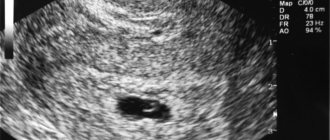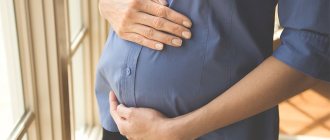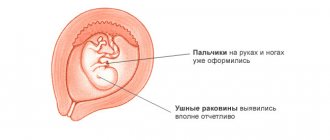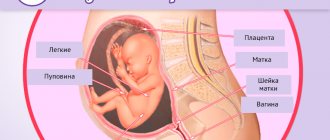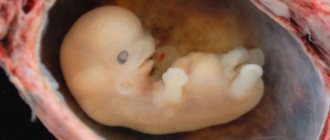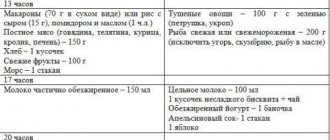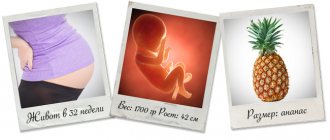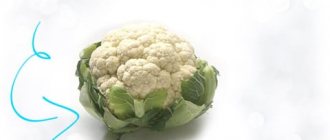What happens to the babies and mother
By the end of the 26th week, a pregnant woman is surprised to note some changes occurring in her well-being and with her body. The parameters of babies also change.
Weight, height and development of fruits
Each of the crumbs in the womb. reaches the size of a small head of cauliflower.
| Head circumference | 267 mm |
| Femur length | 51 mm |
| Tummy circumference | 236 mm |
| Weight | 975 g |
| Height | 36.1 cm |
This week we can note the following features of the development of twins:
- Babies already know how to suck a finger, open and close their eyes, turn their heads towards sound or light, without turning their entire body.
- The brain of fetuses develops especially actively, the auditory system completes its development, and babies can hear the sounds around them.
- Boys' testicles gradually move towards the scrotum from the abdominal cavity. The girls' clitoris is still very prominent and is not covered by the labia.
- Children's skeletons become stronger. Starting this week, all the body’s resources are aimed not at growth in length, but at increasing tissue and muscle mass.
How can they lie
Twins can occupy different positions in the womb, for example:
- Both fetuses are in cephalic presentation. An ideal situation in every way. The expectant mother can count on a natural birth in the absence of contraindications.
- Both babies are in breech presentation. The case is not the most successful, it is unlikely that it will be possible to give birth naturally - in such cases, delivery is carried out by cesarean section.
- The first fetus is in a breech presentation, the second is in a cephalic presentation. Often doctors in this case allow natural birth of twins, provided that the first baby born is in the cephalic presentation. During the birth process, the second fetus may change position. Or the first baby will stretch the mother's birth canal, allowing the second fetus to emerge from the buttocks. But if the first baby is in a breech position and the second is in a breech position, the risks increase significantly. It is best to resort to surgery.
- One of the twins is in a cephalic or pelvic presentation, and the second is positioned transversely. This situation also requires surgery.
- Transverse presentation of both fetuses. Natural childbirth is not possible.
The characteristics of childbirth directly depend on the presentation of the first fetus. But even if both babies are positioned correctly, this does not mean that the birth will necessarily be spontaneous.
Unforeseen difficulties may arise during the process. Often, women pregnant with twins give birth by caesarean section.
Mom's weight gain and uterine size
At 27 weeks, the size of the belly of a woman pregnant with twins seems many times larger in comparison with the same parameters of expectant mothers of one baby. The uterus rises much higher than normal and reaches the size of a basketball, located just under the ribs.
The mother's total weight gain during this period is 11-13 kg. Throughout the week, she is not recommended to gain more than 500 g.
Photos of bellies:
[Show slideshow]
Feelings and well-being of a pregnant woman
At the 20th week of pregnancy with twins, the expectant mother notes the presence of symptoms typical of the third trimester.
These include:
- Painful sensations in the lower back and back. Caused by a growing uterus and increasing weight of the fetuses. The center of gravity of the woman’s body shifts, the ligaments of the spine relax. Pain can bother the expectant mother not only when she is sitting or standing, but also during night sleep.
- Constipation. Frequent companions of pregnancy, intensifying in the 3rd trimester. The enlarged uterus puts more and more pressure on the intestines, causing difficulties in its work. To eliminate unpleasant symptoms, the expectant mother is advised to maintain physical activity, drink more fluids and eat foods with sufficient fiber content.
- Haemorrhoids. Often observed in the 2nd and 3rd trimesters of pregnancy. The uterus compresses the blood vessels, and blood stagnates in the veins of the rectum.
- Stretch marks. They are observed in approximately half of pregnant women after 25 weeks. In some cases, stretch marks are pale and slightly noticeable, in others they are large, bright purple. As babies grow, the belly expands, stretching the skin. The connective tissue under the cover cannot withstand it and breaks down. The appearance of stretch marks is largely due to heredity.
- Itching in the abdominal area. It can be quite strong and occurs as a result of stretching and dryness of the skin of the abdomen. Regular moisturizing of the skin will help cope with this feature.
- Weakness and dizziness. In these cases, pregnant women are advised to lie down and raise their legs up, thereby ensuring blood flow to the head.
- Also, pregnant women are prone to frequent worries , which is quite normal for a woman carrying a child. However, if anxiety develops into panic or depression, you should consult a psychotherapist.
Movements
Most expectant mothers note that movements during a twin pregnancy begin earlier than during a singleton pregnancy, at about 17-18 weeks. This is due to the fact that during multiple pregnancies, the free space of the uterus decreases much faster.
It is not always easy for a pregnant woman to determine exactly where each twin is located. The baby, located higher in the uterus, often begins to move earlier. Already from 23 weeks, a woman can distinguish her twins from each other.
Advice: towards the end of 27 weeks, you should start counting the number of movements your babies make within 12 hours. Each of the twins must make at least 10 movements during this time. In this case, periods of rest (3-4 hours) are allowed when the babies sleep. If by the middle of the 2nd trimester the fetus does not move for 10 hours, you should consult a doctor.
What causes nagging, aching pain during pregnancy?
Unpleasant sensations during gestation may be the result of the norm, or indicate a problem in the system:
- By the beginning of the third trimester, the expectant mother may feel training contractions. They manifest themselves as short-term and mild pulling conditions in the uterine area, which are considered normal.
- Since pressure is also felt on the stomach, the expectant mother, especially after eating, may feel heaviness in her stomach. Due to indigestion, sometimes gastric contents enter the mouth through the esophagus. Heartburn is often present.
- Such signs, coupled with the absence of discharge and poor general health, are considered the norm. The uterus enlarges, the woman’s hormonal background changes, and a slight displacement of the internal organs is observed. During this period, discomfort in the back and lower back may develop.
You can ease the sensations or get rid of them completely if you spend more time in the fresh air, eat small portions, include healthy foods in your diet, do not exert yourself physically, and avoid stress.
If the pain is cramping, one-sided, radiates to the side, intensifies in a supine position, and is accompanied by accompanying symptoms (fever, vomiting, constant constipation, discharge, etc.), then it is not advisable to postpone a visit to the doctor.
There are different reasons: threat of miscarriage, non-gynecological pathologies, genitourinary disorders, etc.
At week 27, any abnormalities should be checked, because during this period there is a possibility of premature birth.
What can be seen on an ultrasound
As a rule, a routine ultrasound at the 27th week of pregnancy with twins is not prescribed, except in cases where the pregnancy is complicated.
During an ultrasound, a specialist can evaluate a number of indicators:
- weight of fruits;
- circumference of heads and tummies;
- Features of the development of twins according to the term.
If during previous ultrasounds it was not possible to determine the gender of twins, it’s time to do it now - the genitals of girls and boys are already quite distinguishable.
Belly at 27 weeks of pregnancy: tugs, hurts
Minor pain in the abdominal area is also likely. But the pain in this case really should be insignificant and not constant, otherwise there is every reason to suspect any complications that cause abdominal pain. A nagging, unobtrusive pain on the sides of the abdomen is considered normal - the ligaments holding the uterus become increasingly soft and stretched, which explains the presence of pain. It is especially noticeable at the moment when a woman bends over, changes her body position, or gets up from a chair or bed. Abdominal pain can also be associated with disruption of the digestive system. Bloating, constipation, increased gas formation - all this leads to abdominal pain, in which it is better to discuss further “nutritional strategy” with your doctor. But if your stomach hurts and pulls at the bottom, the pain is aching for a long time, it is better to go to the doctor for an examination without delay. After all, abdominal pain of this kind may well indicate abruption of a normally located placenta. Also, you should immediately seek medical help if contractions become more intense and painful at 27 weeks of pregnancy. Training contractions at the 27th week of pregnancy are most likely already a common occurrence for the expectant mother - Braxton-Higgins contractions usually appear even earlier. At the same time, false contractions are mild, not painful and irregular. If the uterus begins to contract regularly, contractions intensify or increase in intensity, and in addition, there is also rupture of amniotic fluid - urgently call an ambulance: you have started premature labor.
Possible problems
27 obstetric weeks of pregnancy corresponds to 6 months and 1 week from the start of menstruation. During this period, the expectant mother may encounter problems such as uterine tone, swelling, and even leakage of amniotic fluid.
Tightening of the abdomen and increased tone of the uterus
Hypertonicity of the uterus is a contraction of the muscular layer of the reproductive organ, which can occur even before the onset of labor.
Often, increased uterine tone at 27 weeks leads to premature birth.
If hypertonicity does not last long and does not cause pain, this phenomenon is considered normal.
If the uterus seems to be turning to stone, you feel a tugging sensation in the lower abdomen, accompanied by pain and yellowish or bloody discharge, you should immediately consult a doctor.
Carrying twins creates increased stress on the uterus, which provokes hypertension much more often. Polyhydramnios also plays an important role. The expectant mother of twins should be under the supervision of a doctor throughout her pregnancy.
Hypertonicity is dangerous because it can provoke placental abruption, leading to impaired fetal development and even premature birth.
To avoid possible problems, a pregnant woman should regularly visit a gynecologist and listen to his recommendations. Medications can only be taken on the advice of a doctor. If a specialist recommends sending a woman to a hospital for the sake of preserving the babies, hospitalization should not be neglected.

You might be interested to know
When do you go on maternity leave if you have twins? How to prepare documents and who can go on such leave?
What should a bottle be like for premature babies? Find out here.
Edema
Swelling during pregnancy is the most common complaint of expectant mothers. Most often, the upper and lower extremities swell; women are surprised to note that their usual shoes have become too small for them.
Swelling is directly related to difficulty in the outflow of venous blood and fluid retention in a woman’s body.
A pregnant woman should remember that swelling is not always harmless. In some cases, they may be warning signs of preeclampsia.
If swelling is accompanied by severe weight gain, visual disturbances, abdominal pain, vomiting and other symptoms, you should immediately consult a doctor.
The water has broken or is leaking
Often, twins are born earlier than one child located in the uterus. A woman carrying twins should be attentive to her health, monitoring the beginning of possible water leakage. Indicators of this process are vaginal discharge, which may be clear or slightly greenish.
The main causes of leakage of amniotic fluid are rupture of the membranes or its infection, pathologies and shortening of the cervix. At the first sign or suspicion of water breaking, you should consult a doctor.
To prevent further premature births, you should regularly attend ultrasound, CTG and other procedures during pregnancy, monitoring the condition of the woman’s reproductive organs and babies in the womb.
It's hard to walk
The expectant mother of twins gains more weight and faster than women carrying one child. The growing belly puts pressure on the internal organs and parts of the spine, limiting the physical activity of the pregnant woman. Often the 27th week of multiple pregnancy is marked by heaviness in the lower extremities, interfering with movement.
Cramps in the leg muscles become frequent companions of expectant mothers during this period. The reasons for these unpleasant phenomena are not fully understood.
According to some doctors, convulsions can be a consequence of poor circulation and dehydration of the body. Women who experience this symptom are advised to bend their feet to alleviate their condition, as well as drink 8-12 glasses of water daily.
The expectant mother must remember that she is contraindicated from standing for long periods of time.
To prevent pain in the lower extremities from becoming unbearable, pregnant women should rest more often by placing a bolster or pillow under their knees. Also, you should not cross your legs when sitting down. You should not walk too fast so as not to aggravate the pain in your legs.
How can I sleep if I can't?
Women pregnant with twins experience discomfort not only during physical activity, but even during sleep. A rounded belly often interferes with a good night's rest, and expectant mothers suffer from insomnia.
A timely ultrasound procedure can help the mother of twins.
Having determined the location of the babies in the uterus, you can choose a position that is comfortable for sleeping. If the fetuses are breech, it is better to sleep on the side where the babies' heads are located. It is recommended to turn over from side to side at least 3 times during the night.
Also, the expectant mother should consider some useful tips for organizing a night's rest:
- Set up biorhythms. The healthiest thing is to go to bed and wake up at the same time. It is better for pregnant women to go to bed no later than 22.00 and get up before 8.00 in the morning.
- Use a pillow. An ideal option is one designed specifically for pregnant women, made in the shape of a horseshoe.
- Maintain a daily routine. It is better to leave emotional and mental activity for the first half of the day. Before going to bed, it is useful to take walks and exercise - physical activity contributes to the development of drowsiness.
- You should have dinner 3 hours before going to bed , however, you should not overeat.
- Humidify the air in the room before going to bed.
It is also useful for the expectant mother to drink chamomile tea or milk with cinnamon and honey before going to bed.
What you need to know and what to pay attention to
A woman pregnant with twins should pay close attention to her daily routine, physical activity and nutritional habits. You should also carefully monitor your well-being so as not to miss the alarming symptoms of early premature labor.
What is the probability of childbirth?
Children with multiple pregnancies develop faster than with singleton pregnancies. Therefore, childbirth at the 27th week of pregnancy with twins does occur, although not too often.
Premature delivery is usually caused by shortening or dilation of the cervix, expulsion of the placenta, and other factors.
Forecast of children's health at birth at this stage
If a pregnant woman feels more than 5 contractions per hour, accompanied by lower back pain and bleeding, she should immediately call an ambulance - most likely, labor will begin. A woman should not hesitate - it is possible to stop premature birth with the help of medications, but only if the uterus has not yet dilated.
Twins born at 27 weeks have a much better chance of survival than babies born a week earlier. And yet, children are at risk for possible congenital health problems. After a premature birth, mother and babies remain in the hospital for a long time.
Newborns do not yet know how to independently maintain body temperature, digest food, and sometimes even breathe. Being born so early is a real challenge for a baby - he is born with a lot of lubricant, very short nails, soft cartilage and fluff on his body. The first cry of such babies is usually very weak.
As a rule, specialists successfully care for babies born at 27 weeks, provided that their weight is more than 1 kg.
For information: according to medical statistics, children born at 27 weeks survive and fully develop in the future with a 90% probability.
What does a baby born at 27 weeks of pregnancy look like:
Sex
Physical intimacy during pregnancy with twins at 27 weeks is allowed provided there are no contraindications or complications.
In any case, the fact of sexual contacts and their frequency should be discussed with a gynecologist.
Regular intimacy is beneficial for both partners because it brings positive emotions, helps release the tension, and strengthens the bond between parents-to-be.
Important! Even in cases where doctors allow sex at 27 weeks of pregnancy, partners should be extremely careful. Intimacy should involve exclusively those positions that do not provoke pressure on the abdomen. Of course, a woman must be sure that her partner does not have sexually transmitted infections.
Physical activity
Pregnancy, including multiple pregnancy, does not at all exclude the physical activity of expectant mothers at almost all stages. Light gymnastics, Pilates, yoga, and swimming are recommended for pregnant women.
This statement, however, is true only if there are no contraindications and the placenta is located normally. If the placenta is low, physical activity should be avoided.
Experts recommend doing moderately intense exercise, about half an hour a day, several times a week.
We should not forget that supine poses are contraindicated for pregnant women. The same applies to the “upside down” position or positions in which a woman can fall and injure her stomach.
Walking outdoors is also a form of physical activity. Daily walking for 15 minutes twice a day will energize a pregnant woman and give her strength.
Nutrition
It is extremely important for a pregnant woman to try to follow the principles of proper nutrition:
- It is best to eat small portions 5-6 times a day. This approach will avoid digestive problems.
- The diet of the expectant mother should be varied. It is useful to include lean meat, seasonal vegetables and fruits, cereals, and dairy products in the menu.
- An important part of a pregnant woman's diet is seafood and fish. However, there are some limitations to keep in mind here. The Russian Ministry of Health recommends that expectant mothers eat 500 g of fish per week. But not all seafood is equally beneficial for the body of mothers and babies. A woman should not eat ocean fish (shark, swordfish, marlin, tuna). “Safe” fish species are catfish, flounder, halibut, pollock, haddock, hake, and trout.
- You should also not forget about the drinking regime - you should drink at least 2 liters of clean water per day.
You might be interested to know
Which formula is best for premature and low birth weight babies?
When do premature babies begin to see and hear after birth? All the features of baby development are in this article.
Why see twins in a dream? Find out here.
How to get rid of edema during pregnancy?
After determining the cause of edema, a natural question arises: how to deal with pathological edema (gestosis in pregnant women)? First of all, you need to decide on a diet. Nutrition should be balanced and complete. Food should contain an increased amount of protein (meat, fish, chicken), since with gestosis a deficiency occurs, which leads to increased vascular permeability.
We should not forget about carbohydrates - this is an energy material; if they are lacking, proteins will be consumed as energy. Fats are also necessary for energy production and as a building material for fetal organs. Limiting fluid and salt only aggravates the development of edema. There should be at least 1.5 liters of fluid per day. But it is better to exclude over-salted, pickled and spicy dishes. You should limit your intake of sweet and carbonated drinks (Coca-Cola, lemonade): they lead to fluid retention in the body, creating a vicious circle of edema development.
Try to avoid prolonged standing or walking. In the morning you need to raise your legs up (in a horizontal position). A vigorous foot massage is effective. Kidney tea and other herbal teas can only be taken as prescribed by a doctor. It is strictly prohibited to take diuretics to treat edema caused by gestosis.
In the third trimester of pregnancy, when a significantly enlarged uterus puts pressure on all organs of the abdominal cavity, including the kidneys and renal vessels, positional gymnastics helps well, specifically the knee-elbow position for 1-1.5 hours a day. These 1.5 hours can be gained by short “approaches to the apparatus” for 10-15 minutes throughout the day.
If, despite prevention, swelling continues to increase, protein appears in the urine and pressure creeps up - this is already clinically pronounced gestosis, which can only be treated in a hospital. In severe cases, the question of early delivery may arise, both in the interests of the mother and for the benefit of the child. Please do not refuse hospitalization.
When to go to the doctor
A number of symptoms during multiple pregnancy may indicate serious complications:
- Severe swelling of the ankles and feet. May indicate preeclampsia.
- Vaginal discharge and bleeding that are atypical in appearance and smell.
- Abdominal cramps, severe pain in the pelvis and lower back.
- Severe shortness of breath, difficulty breathing.
- Decreased fetal activity or complete cessation of movements.
- High blood pressure.
The expectant mother should take control of any unusual symptoms that continue for a long time.
You should seek medical help if you have any infections:
- Respiratory (cough, runny nose, elevated body temperature).
- Intestinal (abdominal pain, frequent loose stools, nausea, vomiting, fever).
- Genitourinary (pain, itching, burning in the external genital area, frequent painful urination, blood in the urine).
When visiting a specialist, you should tell him in as much detail as possible about your health and accompanying symptoms.
Discharge at 27 weeks of pregnancy
As before, keep the quantity and quality of discharge under control. Normal discharge for this period is moderate, homogeneous, light or light milky discharge without a pronounced odor. A woman should be alerted to discharge of an unhealthy green-gray, yellow, earthy, brown color. A change in the color of the discharge, combined with the addition of a sharp unpleasant odor, and even against the background of noticeable discomfort in the genital area in the form of itching or burning, painful urination, is a sure sign of the development of an infection. A change in the consistency of the discharge will also indicate the presence of a genital infection: infectious diseases of the genital tract make the discharge cheesy, foamy, bubbling... It is advisable to immediately go to the doctor if liquid, watery, possibly yellowish discharge is detected. With increased discharge of this nature, leakage of amniotic fluid will most likely be diagnosed. If the membranes are damaged, amniotic fluid may well leak in small portions, only creating an increased feeling of moisture in the perineal area. If the amniotic fluid comes out all at once, rush to call an ambulance - the outpouring of water indicates the onset of premature labor. Do not hesitate to seek medical help if you experience bloody, brown discharge. The presence of blood on panties may indicate placenta previa or abruption of a normally located placenta. Typically, placental abruption is also accompanied by abdominal pain.
